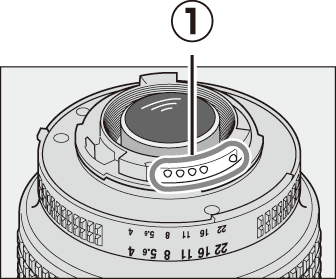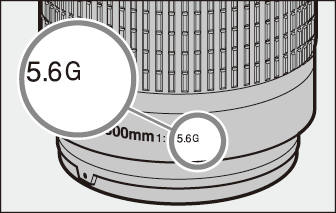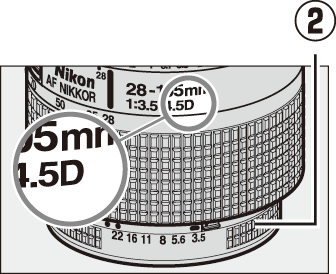Compatible F Mount Lenses
CPU lenses are recommended (but note that IX-NIKKOR lenses cannot be used). Types G, E, and D, which grant access to a full range of camera features, are particularly recommended.
CPU Lenses
|
Lens 1/accessory |
Autofocus 2 |
Shooting mode |
Metering |
||||
|---|---|---|---|---|---|---|---|
|
P |
A |
L |
M |
t |
|||
|
3D-RGB |
RGB |
||||||
|
Type G, E, or D 3; AF‑S, AF‑P, AF‑I |
4 |
4 |
4 |
4 |
— |
44 |
4 |
|
PC NIKKOR 19mm f/4E ED 6 |
— |
45 |
45 |
45 |
— |
44, 5 |
45 |
|
PC-E NIKKOR series 6 |
— |
45 |
45 |
45 |
— |
44, 5 |
45 |
|
PC Micro 85mm f/2.8D 6, 7 |
— |
— |
48 |
45 |
— |
44, 5 |
45 |
|
AF‑S/AF‑I Teleconverter 9 |
4 |
4 |
4 |
4 |
— |
44 |
4 |
|
Other AF NIKKOR (except lenses for F3AF) |
4 10 |
4 |
4 |
— |
4 |
44 |
— |
|
AI-P NIKKOR |
— |
4 |
4 |
— |
4 |
44 |
— |
-
IX-NIKKOR lenses cannot be used.
-
M (manual focus) is available with all lenses.
-
Vibration reduction (VR) is supported with VR lenses.
-
[] meters the selected focus point.
-
Cannot be used with shifting or tilting.
-
Fog, lines, and other image artifacts (“noise”) may appear in photos taken with the electronic front-curtain shutter. This can be prevented by selecting [] for Custom Setting d5 [].
-
The camera’s exposure metering and flash control systems will not function as expected when the lens is shifted and/or tilted, or when an aperture other than the maximum aperture is used.
-
Mode M (manual) only.
-
For information on the focus points available for autofocus and electronic rangefinding, see “AF-S/AF-I Teleconverters” (AF-S/AF-I Teleconverters).
-
When an AF 80–200mm f/2.8, AF 35–70mm f/2.8, AF 28–85mm f/3.5–4.5 <New>, or AF 28–85mm f/3.5–4.5 lens is focused at the minimum distance at maximum zoom, the in-focus indicator may be displayed when the image on the matte screen in the viewfinder is not in focus. Adjust focus manually until the image in the viewfinder is in focus.
-
“Noise” in the form of lines may appear during autofocus at high ISO sensitivities. Use manual focus or focus lock. Lines may also appear at high ISO sensitivities when aperture is adjusted during movie recording or live view photography.
The f-number is a measure of lens “speed”, its maximum (widest) aperture. It appears at the end of the lens name, for example as “f/2.8” or “f/3.5–5.6”.
The lenses listed below are not recommended for long exposures or photographs taken at high ISO sensitivities, as due to the design of the vibration reduction (VR) control system the resulting photos may be marred by fog.
-
AF‑S VR Zoom-Nikkor 24–120mm f/3.5–5.6G IF‑ED
-
AF‑S VR Zoom-Nikkor 70–200mm f/2.8G IF‑ED
-
AF‑S VR Zoom-Nikkor 70–300mm f/4.5–5.6G IF‑ED
-
AF‑S VR Nikkor 200mm f/2G IF‑ED
-
AF‑S VR Nikkor 300mm f/2.8G IF‑ED
-
AF‑S NIKKOR 16–35mm f/4G ED VR
-
AF‑S NIKKOR 24–120mm f/4G ED VR
-
AF‑S NIKKOR 28–300mm f/3.5–5.6G ED VR
-
AF‑S NIKKOR 400mm f/2.8G ED VR
-
AF‑S NIKKOR 500mm f/4G ED VR
-
AF‑S DX VR Zoom-Nikkor 18–200mm f/3.5–5.6G IF‑ED
-
AF‑S DX NIKKOR 16–85mm f/3.5–5.6G ED VR
-
AF‑S DX NIKKOR 18–200mm f/3.5–5.6G ED VR II
-
AF‑S DX Micro NIKKOR 85mm f/3.5G ED VR
-
AF‑S DX NIKKOR 55–300mm f/4.5–5.6G ED VR
We recommend turning vibration reduction off when using other VR lenses.
The camera can be used with Nikon lenses for 35 mm format cameras. If a 35 mm format lens or a lens that supports the FX format is attached, the angle of view will be the same as a frame of 35 mm film.
-
You can also take pictures at angles of view that differ from that of the current lens by selecting different options for [] > [] in the photo shooting menu. For example, if a 35 mm format lens or a lens that supports the FX format is attached, you can reduce the angle of view by selecting [].
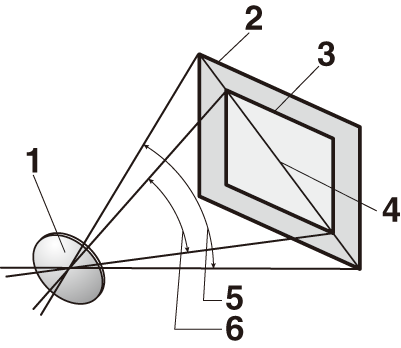
1 Lens
2 [] picture size (35.9 × 23.9 mm, equivalent to 35 mm format camera)
3 [] picture size (23.5 × 15.7 mm)
4 Picture diagonal
5 [] angle of view (35 mm format)
6 [] angle of view
-
The picture diagonal for 35 mm format is about 1.5 times that of the [] crop. Selecting [] therefore multiplies the apparent focal length of 35 mm format lenses attached to the camera by about 1.5×. For example, selecting [] when a lens with a focal length of 50 mm is attached increases the apparent focal length to about 75 mm.
-
The table below shows the focus points available for autofocus and electronic rangefinding in viewfinder photography when an AF-S/AF-I teleconverter is attached. Note that the camera may be unable to focus on dark or low-contrast subjects if the combined aperture is slower than f/5.6.
Teleconverter
Max. lens aperture
Focus points
TC-14E, TC-14E II, TC-14E III
f/4 or faster
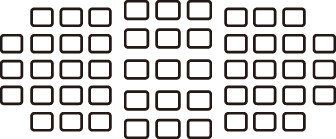
f/5.6
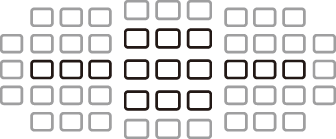 1
1TC-17E II
f/2.8 or faster

f/4
 1
1f/5.6
— 2
TC-20E, TC-20E II, TC-20E III
f/2.8 or faster

f/4
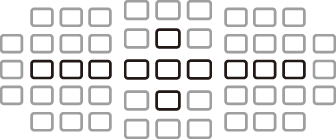 3
3f/5.6
— 2
TC-800-1.25E ED
f/5.6
 1
1-
Single-point AF is used when 3D-tracking or auto-area AF is selected forAF-area mode.
-
Autofocus not available.
-
Focus data for focus points other than the center focus point are obtained from line sensors.
-
-
Autofocus is not available when teleconverters are used with the AF-S VR Micro-Nikkor 105mm f/2.8G IF-ED.
CPU lenses can be identified by the presence of CPU contacts (q). Type G lenses are marked with a “G”, type E lenses with an “E”, and type D lenses with a “D”. Type G and E lenses are not equipped with a lens aperture ring (w).
|
CPU lens |
Type G or E lens |
Type D lens |
Non-CPU Lenses and Other Accessories
|
Lens 1/accessory |
Shooting mode |
Metering |
||||
|---|---|---|---|---|---|---|
|
P |
A |
L |
M |
t |
||
|
3D-RGB |
RGB |
|||||
|
AI-, AI-modified NIKKOR or Nikon Series E lenses 2 |
— |
4 3 |
— |
4 4 |
4 5 |
— |
|
Medical-NIKKOR 120mm f/4 |
— |
4 6 |
— |
— |
— |
— |
|
Reflex-NIKKOR |
— |
4 3 |
— |
— |
4 5 |
— |
|
PC-NIKKOR |
— |
4 7 |
— |
— |
4 |
— |
|
AI-type Teleconverter 8 |
— |
4 3 |
— |
4 4 |
4 5 |
— |
|
PB-6 Bellows Focusing Attachment 9 |
— |
4 10 |
— |
— |
4 |
— |
|
Auto extension rings (PK‑series 11A, 12, or 13; PN‑11) |
— |
4 3 |
— |
— |
4 |
— |
-
Some lenses cannot be used (Incompatible Lenses and Accessories).
-
The range of rotation for the AI 80–200mm f/2.8 ED tripod mount is limited by the camera body. Filters cannot be exchanged while an AI 200–400mm f/4 ED is mounted on camera.
-
If the maximum aperture is specified using the [] item in the setup menu, the aperture value will be displayed in the viewfinder and control panel.
-
Can be used only if the lens focal length and maximum aperture are specified using the [] item in the setup menu. Some lenses may, however, fail to produce the desired results even if the focal length and maximum aperture are supplied. Use [] or [] if the desired results are not achieved.
-
For improved precision, specify the lens focal length and maximum aperture using the [] item in the setup menu.
-
Can be used in mode M at shutter speeds one step or more slower than the flash sync speed.
-
Use stop-down metering. In mode A, stop aperture down using the controls on the lens and lock exposure before shifting the lens. In mode M, stop aperture down using the controls on the lens and meter exposure before shifting the lens.
-
Exposure compensation required with AI 28–85mm f/3.5–4.5, AI 35–105mm f/3.5–4.5, AI 35–135mm f/3.5–4.5, or AF‑S 80–200mm f/2.8D lenses.
-
Requires a PK-12 or PK-13 auto extension ring. A PB-6D may be required depending on camera orientation.
-
Can be used with stop-down metering; in mode A, stop aperture down using the controls on the bellows attachment and meter exposure before taking photographs.
-
Lines may appear at high ISO sensitivities when aperture is adjusted during movie recording or live view photography.
The following non-CPU lenses and accessories cannot be used. Attempting to mount them on the camera could damage the camera or lens.
-
TC-16A AF teleconverters
-
Non-AI lenses (lenses with pre-AI exposure couplings)
-
Lenses that require the AU-1 focusing unit (400mm f/4.5, 600mm f/5.6, 800mm f/8, 1200mm f/11)
-
Fisheye (6mm f/5.6, 7.5mm f/5.6, 8mm f/8, OP 10mm f/5.6)
-
2.1cm f/4
-
K2 extension rings
-
180–600mm f/8 ED lenses (serial numbers 174041–174180)
-
360–1200mm f/11 ED lenses (serial numbers 174031–174127)
-
200–600mm f/9.5 lenses (serial numbers 280001–300490)
-
AF lenses for the F3AF (AF 80mm f/2.8, AF 200mm f/3.5 ED, TC-16 AF teleconverters)
-
PC 28mm f/4 lenses (serial numbers 180900 or earlier)
-
PC 35mm f/2.8 lenses (serial numbers 851001–906200)
-
PC 35mm f/3.5 lenses (old type)
-
Reflex 1000mm f/6.3 lenses (old type)
-
Reflex 1000mm f/11 lenses (serial numbers 142361–143000)
-
Reflex 2000mm f/11 lenses (serial numbers 200111–200310)
-
Specifying the lens focal length and maximum aperture using the [] item in the setup menu allows many of the features available with CPU lenses, including aperture value display and color matrix metering, to be used with non-CPU lenses. If the focal length and maximum aperture are not provided and [] is selected for metering, [] will be used instead.
-
Aperture must be set using the lens aperture ring. If the maximum aperture is not provided using [], the aperture displays in the camera control panel and viewfinder will show the number of stops from maximum aperture and the actual aperture value must be read off the lens aperture ring.
The Electronic Rangefinder
The conditions under which the electronic rangefinder can be used vary with the lens.
CPU lenses
|
Lens/accessory |
Viewfinder photography |
Live view |
|---|---|---|
|
Type G, E, or D; AF‑S, AF‑P, AF‑I |
4 |
4 |
|
PC NIKKOR 19mm f/4E ED |
4 1 |
— |
|
PC-E NIKKOR series |
4 1 |
— |
|
PC Micro 85mm f/2.8D |
4 1 |
— |
|
AF‑S/AF‑I Teleconverter |
4 |
4 |
|
Other AF NIKKOR (except lenses for F3AF) |
4 2 |
4 |
|
AI-P NIKKOR |
4 3 |
4 |
-
Cannot be used with shifting or tilting.
-
When an AF 80–200mm f/2.8, AF 35–70mm f/2.8, AF 28–85mm f/3.5–4.5 <New>, or AF 28–85mm f/3.5–4.5 lens is focused at the minimum distance at maximum zoom, the in-focus indicator may be displayed when the image on the matte screen in the viewfinder is not in focus. Adjust focus manually until the image in the viewfinder is in focus.
-
With a maximum aperture of f/5.6 or faster.
Non-CPU Lenses and Other Accessories
|
Lens/accessory |
Viewfinder photography |
Live view |
|---|---|---|
|
AI-, AI-modified NIKKOR or Nikon Series E lenses |
4 1 |
— |
|
Medical-NIKKOR 120mm f/4 |
4 |
— |
|
Reflex-NIKKOR |
— |
— |
|
PC-NIKKOR |
4 2 |
— |
|
AI-type Teleconverter |
4 3 |
— |
|
PB-6 Bellows Focusing Attachment |
4 3 |
— |
|
Auto extension rings (PK‑series 11A, 12, or 13; PN‑11) |
4 3 |
— |
-
With a maximum aperture of f/5.6 or faster.
-
Cannot be used with shifting or tilting.
-
With a maximum effective aperture of f/5.6 or faster.

